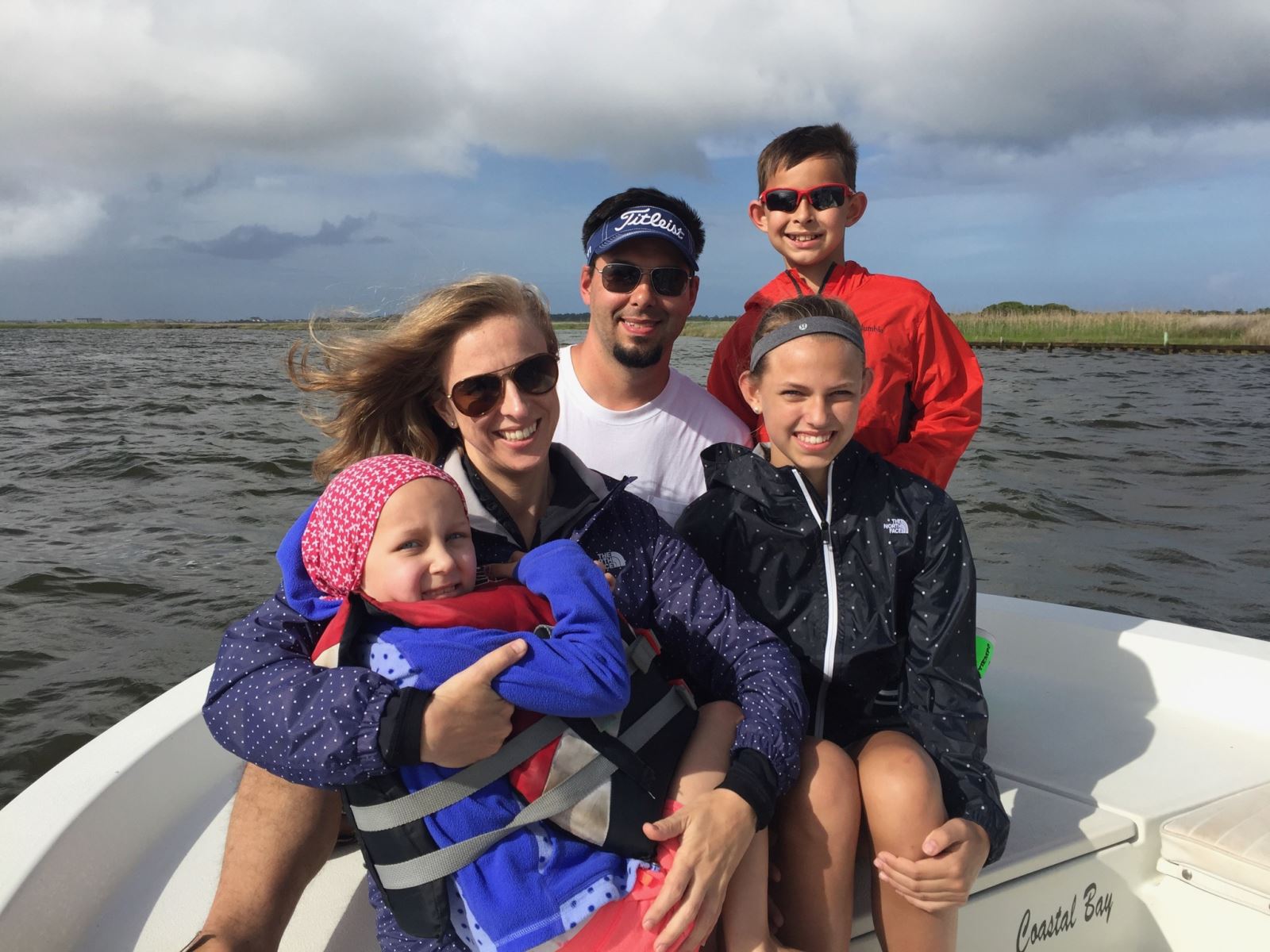
In June, nearly six years after her daughter was diagnosed with cancer, Marisa Cherry stood before a crowd of more than 250 patients, families, employees and community members. As Children’s Hospital of Richmond at VCU broke ground on its new inpatient hospital, Marisa recounted her family’s experiences and how she turned her “family’s worst days” into opportunities to improve experiences for the thousands of children who will be treated at CHoR’s new inpatient facility when it opens in late 2022.
“In that moment, days after receiving a devastating cancer diagnosis,” Marisa told the crowd, “my husband and I realized that while this is the scariest and probably the most challenging time of our lives, our job was not only to get the best care for [Lauren] but to enable a childhood here at the hospital and throughout her treatment.”
A parent’s worst nightmare
In early July 2013, Marisa, her husband, Steve, and the couple’s three children were enjoying their annual beach vacation. Three-year-old Lauren, who had been complaining sporadically of headaches, began experiencing headaches so severe that she was vomiting and couldn’t sleep. The headaches continued to occur randomly, but after another episode the week following vacation, Marisa took Lauren to her pediatrician who ordered a blood test and CT scan.
“In my mind I thought everything would be fine,” Marisa recalled of the morning of Lauren’s CT scan. “But then the radiologist told me ‘your daughter is in imminent danger. We’ve called [Children’s Hospital], and they are waiting for you.’ It was a parent’s worst nightmare.”
Lauren was diagnosed with pineoblastoma, a rare brain tumor, and hydrocephalus, which caused excess fluid to put pressure on her brain. Doctors inserted a tube to drain the excess fluid while her neurosurgeons, Drs. Gary Tye and Ann Ritter, consulted with other specialists across the U.S. about the best surgical option because of the unique location of Lauren’s tumor.
After a week in the Pediatric Intensive Care Unit, Lauren underwent a complex eight-hour procedure to remove the tumor. One of Lauren’s nurses made purple ribbons in honor of Lauren’s favorite color, which her family and friends wore while waiting for the hourly updates from her care team. Although Lauren’s surgery was successful, a month later, doctors discovered that what they thought was a minor surgical complication was pleuropulmonary blastoma, an even more rare lung tumor commonly found in patients with DICER1 syndrome, a genetic disorder that increases the risk for cancerous and noncancerous tumors, which Lauren was found to have. Lauren’s case was unique because individuals with DICER1 typically develop tumors in the lungs first.
Lauren’s doctors, including Dr. India Y. Sisler, medical director, hematology and oncology, continued to collaborate with specialists across the country to determine the best treatment.
“Pediatric oncology is a tight knit, small community,” said Dr. Sisler. “Collaboration is built in to our specialty. We are the only bone marrow transplant center in the state, [which brings patients to CHoR]. When we have patients who need specialized care not offered here, we send them elsewhere.”
Collaboration with other CHoR specialists has been enhanced since the opening of the Children’s Pavilion in 2016. With all physicians in the same space, it’s easy to coordinate care across specialties or visit with a patient when they’re at CHoR for other appointments. The new inpatient facility will be connected to the Pavilion and have a dedicated bone marrow transplant space, allowing patients better access to all providers and services.
“The clinic is a second home for our patients,” said Dr. Sisler. “The physical continuity of the new hospital will allow our staff to move back and forth easily between clinic and the inpatient unit.”
Preserving childhood
Throughout Lauren’s years of treatment, which included a relapse in May 2015, she has seen specialists at six children’s hospitals, spent countless nights in hospitals, and undergone four surgeries, more than 100 doses of chemotherapy, three high dose chemo bone marrow transplants, countless invasive procedures, and 31 rounds of radiation to her brain and spinal cord. She has also celebrated birthdays, built blanket forts, created art projects, danced, cuddled with dogs, visited with family and friends, and experienced many other joys of childhood, all while in the hospital. Marisa and Steve had Lauren baptized in CHoR’s children’s garden, and with the help of others, turned a conference room into a Thanksgiving feast, decorated her hospital room with a purple Christmas tree, and threw parties when Lauren needed to be cheered up.
“Be as normal as possible, even if you have to pretend,” Marisa recalled of advice she received early during Lauren’s treatment. “We worked hard to ensure the worst days had happy moments. We believe that it is a part of the reason Lauren is doing well because she felt some normalcy, and it helped her cope.”
.jpg)
“Picture day”
After Lauren’s initial treatment was complete, she returned to CHoR every three months for MRIs to monitor for new tumors. At that time, the Pavilion hadn’t been built, and pediatric patients were seen in the same location as adult patients. Scheduling Lauren’s four-hour MRI required long lead times, and Marisa recalled the fear and stress she and Steve experienced in the days leading up to the tests as they worried about the results. That underlying anxiety was compounded on MRI days with long waits in small, windowless rooms while Lauren, who was not allowed to eat or drink before the test, worried about going to sleep with anesthesia. Marisa described the opening of the Pavilion and dedicated imaging space as “changing the dynamic” because scheduling has become easier, and Lauren now looks forward to MRIs, or “picture day” as she calls it.
Lauren described how her favorite nurse gave her sunglasses and a pillowcase and how she got to play “I Spy” while waiting for the bubble gum-flavored “sleepy medicine.” This spring, she had her first MRI without anesthesia and was excited to wear special goggles that allowed her to watch her favorite movie, “How to Train Your Dragon,” and talk to the imaging team during the procedure. (The goggles were funded by donations to Children’s Hospital Foundation.)
“Those are the kind of details that make a huge difference,” Marisa said. “The little things make it so much easier to cope.”
Transforming family experiences
Throughout Lauren’s treatment, Marisa and Steve partnered with the care team, asking questions and providing feedback to get the best outcomes for Lauren. A few years ago, Marisa joined CHoR’s Family Advisory Network to use her experiences at CHoR to influence changes and improve experiences for other patients and families. As part of CHoRFAN, she has been actively involved in the planning process for the new inpatient facility.
Although CHoR has always relied on patient and family feedback, participation from CHoRFAN members has “been exceptional” with the new hospital planning, said Kate Renner, an associate with HKS, the hospital’s architecture firm. As an architect and design researcher, Kate brings best practices from other top 20 children’s hospitals and engages families during the planning process. During quarterly meetings with CHoRFAN members, the design team has shared models of patient rooms, layouts of inpatient floors and will soon solicit feedback on colors and furniture options.
Marisa has been involved from the beginning, advocating for everything from dedicated pediatric imaging spaces, operating rooms and an emergency room to the layout of private patient rooms, bathrooms, and work, exercise and flexible gathering areas. She also was a strong advocate for connecting the Pavilion to the new hospital to make it easier to admit patients from outpatient clinics, something that often occurs with hematology and oncology patients.
 Hitting the beach
Hitting the beach
Although Lauren’s health has been stable for the last two and a half years, she returns to CHoR for quarterly MRIs and check ups with the hematology and oncology team. While chemotherapy and radiation targeted her cancerous cells, they also led to hearing loss and thyroid problems, which are treated by CHoR specialists from audiology and endocrinology. Even through her medical challenges, Marisa said Lauren has remained a “spitfire and very determined, which has served her well.”
As the Cherrys prepared for their annual beach vacation this summer, Lauren talked about building sandcastles, going fishing, and swimming in the pool and ocean. She recently completed second grade and was excited to spend time with her older brother, Jackson, and sister, Ava, who wants to be a doctor after spending so much time in the hospital with Lauren.
“Let’s celebrate how far CHoR has come,” Marisa challenged the crowd at the groundbreaking in June, “but even when the walls are built and the paint is dry, let’s never stop working together to build a place that provides children and families with the best care and the best memories even on their worst days.”
